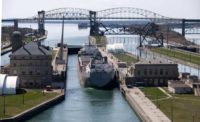Senate and House committees are laying the groundwork for a new water-resources bill this year that would authorize federal funds for new Army Corps of Engineers flood protection and other types of projects and might also include some policy changes.
The goal is to keep to a schedule of passing a new Water Resources Development Act, or WRDA, every two years. After a long period of missing that goal, Congress did approve new water measures in 2014 and 2016.
WRDAs traditionally have enjoyed bipartisan backing. The 2016 version, the Water Infrastructure Improvements for the Nation Act, cleared the House 360-61 and the Senate 78-21.
But it’s unclear whether a new WRDA can survive the major partisan battles that continue to rage on Capitol Hill in the current Congress, particularly with elections looming and Republicans expected to lose seats in the House.
Another key WRDA-related question is whether legislators will pursue a stand-alone measure or seek to include it in a broader infrastructure package. House and Senate lawmakers and industry officials are still awaiting specifics of President Trump’s promised $1-trillion, 10-year infrastructure investment plan.
Whichever route the WRDA drafters take, they face a tight schedule. Besides the usual holiday and August breaks, the congressional calendar will be cut shorter by a recess in early October to allow lawmakers to campaign full-time for the Nov. 6 elections.
What's more, partisan battles seem heightened this year on Capitol Hill with Election Day on the horizon.
Lawmakers Weigh In
Nevertheless, In the Senate, Environment and Public Works Committee leaders from both parties have said they want to produce a WRDA . Chairman John Barrasso (R-Wyo.) said at a Jan. 10 hearing, “Unlike other contentious issues, historically, Republicans and Democratic members of the [committee] have been able to work together and pass WRDA legislation” he added, “To put it another way, this is legislation that moves.”
The panel’s top Democrat, Tom Carper (Del.), also would like to see WRDA done. Carper said at a Jan 17 committee hearing on water infrastructure that a new WRDA bill "is something that we can work on together. It's not so much red state-blue state. It's not so much Democat-Republican. It's just important stuff., and we realize that." [View hearing webcast here.]
In the House, the Transportation and Infrastructure Committee plans a hearing on water-project delivery issues on Jan. 18.
Committee Chairman Bill Shuster (R-Pa.) “intends to stay on track” regarding the two-year cycle, spokesman Justin Harclerode told ENR via email. Harclerode added: “WRDA 2018 is one the committee’s goals for the year. We are still in the process of gathering input for that bill and listening to what stakeholders have to say.”
Shuster announced on Jan. 2 that he would be leaving the House after his current term is up. John Doyle, special counsel with law and lobbying firm Jones Walker LLP, says, “I have to believe that he would love to be able to have another WRDA bill as part of his committee chairmanship legacy.”
Mike Strachn, a senior adviser with water-resources consulting firm Dawson & Associates, says that a new WRDA “plays well into the rhetoric of infrastructure that the White House as well as Congress are talking about.”
Strachn, who spent 23 years with the Corps, adds, “The politics [for WRDA] is right, notwithstanding the politics being wrong for so much else.”
Strachn, who also was a senior House transportation committee aide, notes that the “cornerstone” of WRDAs has been authorizations of federal funds for new Corps projects. The 2016 measure authorized $10.3 billion for 30 Corps projects; the 2014 law provided $4.4 billion for 34 projects.
Several new projects are already in line for a 2018 bill. According to the Corps, six projects—two in Texas, two in Florida and one each in New York and Hawaii—received favorable reports from the Army’s Chief of Engineers in 2017. Such reports are generally needed before authorization.
By far the largest of the six is a coastal storm protection and environmental restoration project from Sabine Pass to Galveston Bay in Texas. According to the chief's report, dated Dec. 7, the project's estimated total cost is $3.3 billion, including a federal share of $2.16 billion. WRDA bills only authorize federal funding shares.
Nicole Carter, Congressional Research Service natural-resources policy specialist, told the Senate panel that 12 to 18 other projects also may get completed “chief’s reports” by the end of December. All of the authorized funding is subject to appropriations, however. Annual Corps civil-works construction appropriations fall far short of authorized amounts.
Carper said that "much of the Corps' infrastructure is now exceeding its useful lifespan." He also noted that the Corps construction backlog is an estimated $96 billion, which "would only address current needs," not future requirements.
Policy provisions
Besides projects, interest groups have other provisions they would like to see included in a 2018 WRDA. For example, the American Association of Port Authorities is calling for full use of all of the revenue that flows into the Harbor Maintenance Trust Fund, plus all of that fund’s $9-billion surplus, William D. Friedman, Cleveland-Cuyahoga County Port Authority president and CEO, told the Senate committee.
The trust fund is supported by a tax on waterborne freight imports.
Friedman said ports also would like Congress to include further project “streamlining” provisions in the envisioned water bill.
Doyle, a former senior Army civil-works official and House aide, says barge companies and other inland-waterway industry officials are seeking an increase in the federal funding share for locks and dams and other inland navigation projects.
In the 2016 WIIN Act, seaports won a hike in the federal share for dredging projects to 75% for depths of up to 50 ft. Previously, the federal share was 50% for depths from 45 ft to 50 ft.
Story updated on Jan. 20 with new information from the Corps on projects with Chief's reports.




Post a comment to this article
Report Abusive Comment